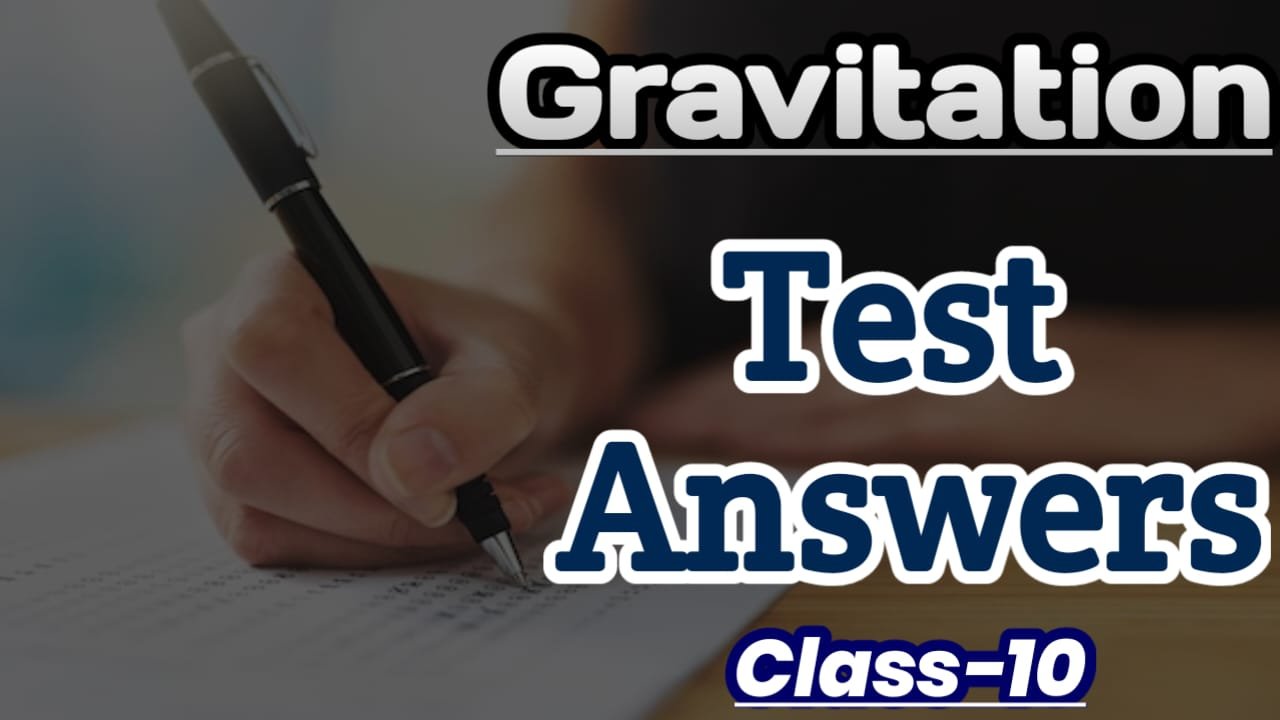Total marks – 40 Time – 2 Hrs.
Q 1 (A) Choose the correct alternatives (5 marks) Gravitation Test Answers
- If the distance between two objects increases 5 times, the gravitational force becomes times.
(a) 5
(b) 15
(c) 1/25
(d) 25
- The gravitational force on the surface of the Moon is …..times than that on the surface of the Earth.
(a) five
(b) one fifth
(c) one sixth
(d) six
- According to Newton’s first law, if mass is more, then the inertia of the body is.
(a) less
(b) Very less
(c) More
(d) Can’t say
- The weight of body gradually decreases from.
(a) equator to poles
(b) Poles to equator
(c) Pole to pole
(d) Height to surface
- A body of mass 1 kg is attracted by the Earth with a force which is equal to.
(a) 9.8 N
(b) 6.67 × 10-11
(c) 1 N
(d) 9.8 m/s
(B) Answer the following ( 5 marks)
1.Fill in the blank.
SI unit of G is …..
Nm2/kg2
2. Gravitational waves are detected by…
LIGO (Laser Interferometric Gravitational Wave Observatory)
3. Find the odd word out: Acceleration, mass, force, weight
Mass (Others are vector quantities)
4. Kinetic energy: 1 /2 mv2: Gravitational Potential energy: …
-GMm/R+h
5. State whether the following statements are True or False. Correct the false statement. Force = mass × velocity
False.
Correct statement – Force = mass x acceleration
Q 2 (A) Give scientific reasons (Any 2) (4Marks)
-
In the spacecraft, travellers and objects appear floating Gravitation Test Answers
- In space, the only force that acts on a spacecraft is the gravitational force of the earth. Therefore, it is in a state of free fall.
- The velocity in free fall is independent of the properties of an object and thus is the same for the spacecraft, the travellers and the objects in the space craft.
- The free fall leads to weightlessness of space travellers as well as object in the spacecraft.
- Being weightless, space travellers as well as objects in the spacecraft appear to be floating.
-
Weight of an object changes from place to place on the surface of the Earth.
- The shape of the Earth is not exactly spherical. It is flattened at poles, while bulged at equator.
- Weight is the Earth’s gravitational force acting on the object, which is generally W = mg.
- Mass of the object remains the same but value of ‘g’ keeps on changing from place to place.
- The value of ‘g’ is maximum at poles i.e. 9.83 m/s2 while it is the least at equator i.e. 9.78 m/s2.
- Due to this the weight of an object changes from place to place on the surface of the Earth.
- It is maximum at poles but gets reduced at equator.
-
The value of 1 kg gold weigh different at pole and equator
- The weight of an object is defined as the force with which the earth attracts the object.
- It is given as, W = F = mg
- The weight of an object depends on the mass of the object and the value of acceleration due to gravity. c.
- On the surface of the earth, the value of g is highest at the poles and decreases slowly with decreasing latitude becoming lowest at the equator
Gravitation Test Answers
(B) Answer the following (Any 3) (6 Marks)
1. Distinguish between mass and weight.

2. Define – free fall, Centripetal force
Free fall
When a body falls towards the Earth under the influence of the Earth’s gravity alone, its motion is called a ‘free fall’.
Centripetal force
The force that acts on any object moving along a circle, directed towards the centre of the circle is called centripetal force.
3. The value of ‘g’ at the centre of the Earth is zero. Explain? Gravitation Test Answers
- The acceleration due to gravity (g) on earth’s surface is given as,
- G = GM / R2
- The value of g depends on the mass M of the earth and the radius R of the earth.
- As we go inside the earth, our distance from the centre of the earth decreases and no longer remains equal to the radius of the earth (R).
- Along-with the distance, the part of the earth which contributes towards the gravitational force felt also decreases, decreasing the value of (M).
- Due to combined result of change in R and M, value of g becomes zero at the centre of the earth.
4. Mahendra and Virat are sitting at a distance of 1 metre from each other. Their masses are 75 kg and 80 kg respectively. What is the gravitational force between them?
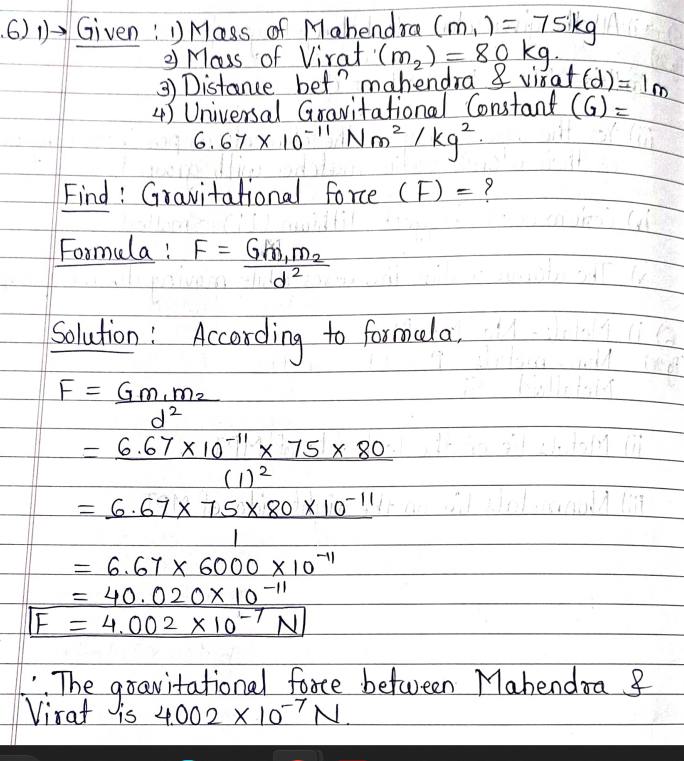
5. Let the period of revolution of a planet at a distance 2R from a star be T. Prove that if it was at a distance of 8 R from the star, its period of revolution will be 8√ T.
According to Kepler’s third law, the square of orbital period of revolution T of a planet around a star is directly proportional to the cube of the mean distance R of the planet from the star.
΅ T 2 α R 3
T 2 = k (R) 3 …. (1)
Where, k is constant of proportionality.
When the planet is at a distance of 2R from the star, then its period of revolution T’ will be,
T’ 2 α (2R) 3
T’ 2 = k (2R) 3 …. (2)
Dividing equations (1) and (2), we get,
T 2 / T’2 = (R) 3 / (2R) 3
T 2 / T’2 = 1/ 8
T’2 = √8 T
Thus, for a planet at a distance of 2R from the star, its period of revolution will be √8 T
Q.3 Answer the following (Any five) (15Marks)
-
What happens to the gravitational force between two objects, if –
-
the mass of the object is doubled
-
the distance between the objects is doubled
-
the mass of both objects are doubled and the distance between them is quadrupled.(4 times)
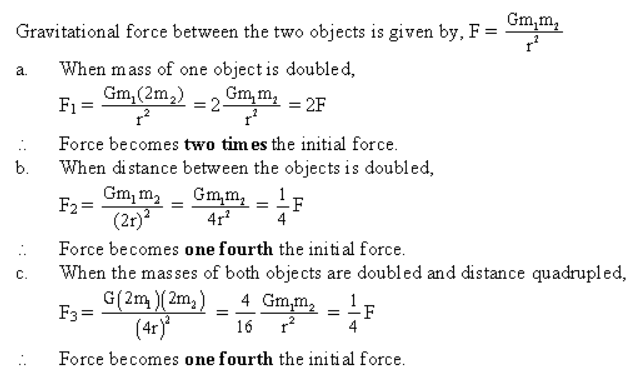
2. A ball is thrown vertically upwards with a velocity of 49 m/s. calculate –
-
the maximum height to which it rises
-
the total time it takes to return to the earth surface.

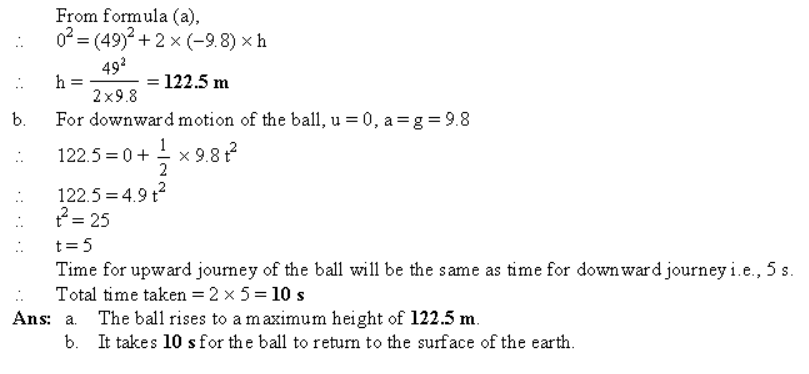
3. Define: The Universal law of gravitation and derive mathematically.

4. Observe the figure and answer the following questions:
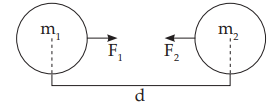
- Write gravitational force between the two objects
According to Newton’s universal law of gravitation, the gravitational force between these two objects will be –

b. What will happen to gravitational force if mass of one of the objects is doubled?
If mass of one of the objects is doubled, then the gravitational force between them will also get doubled as force is directly proportional to the product of the masses of the two objects.
c. What is the value of universal constant in SI system?
The value of universal gravitational constant is 6.67 x 10-11 Nm2/kg2
5. Read the paragraph and answer the questions given below.
Space travellers as well as objects in the spacecraft appear to be floating. Why does this happen? Though the spacecraft is at a height from the surface of the earth, the value of g there is not zero. In the space station the value of g is only 11% less than its value on the surface of the earth. Thus, the height of a spacecraft is not the reason for their weightlessness. Their weightlessness is caused by their being in the state of free fall. Though the spacecraft is not falling on the earth because of its velocity along the orbit, the only force acting on it is the gravitational force of the earth and therefore it is in a free fall state. As the velocity of free fall does not depend on the properties of an object, the velocity of free fall is the same for the spacecraft, the travellers and the objects in the craft. Thus, if a traveller releases an object from her hand, it will remain stationary with respect to her and will appear to be weightless.
- Is the value of g zero in the space station
No, the value of g is only 11% less than its value on the surface of the Earth.
- Why is weightlessness caused in a spacecraft?
The weightlessness is caused by them being in a state of free fall.
- Why doesn’t the spacecraft fall towards the Earth?
The spacecraft does not fall towards the Earth because of its velocity along the orbit.
6. Answer the following questions
- Will the velocity of a stone thrown vertically upwards remain constant or will it change with time? How will it change?
The velocity of the stone thrown vertically upward will not remain constant. It will decrease with time till it becomes zero.
b. Why doesn’t the stone move up all the time? Why does it fall down after reaching a certain height?
When the stone is thrown vertically upwards, the gravitational force tries to pull it down and reduces its velocity. Due to this onstant downward pull, the velocity becomes zero after a while. The pull continues to be exerted and the stone starts moving vertically downward towards the centre of the earth under its influence
c. What does its maximum height depend on?
The maximum height the stone can achieve depends on the initial velocity with which the stone is thrown vertically upwards
7. Define: Escape velocity and derive mathematically.
The velocity required to overcome the Earth’s gravitational force to move into the space is called escape velocity.
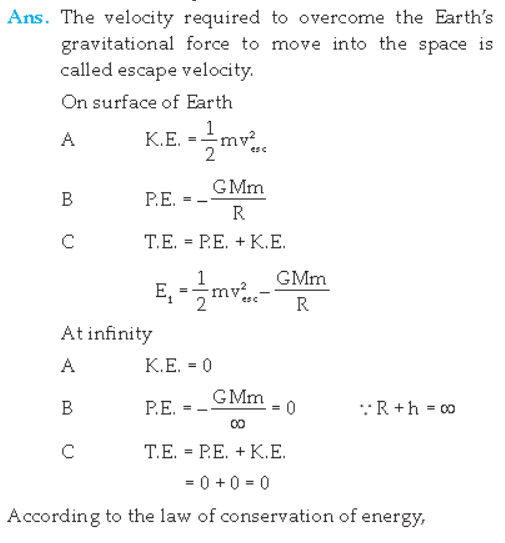
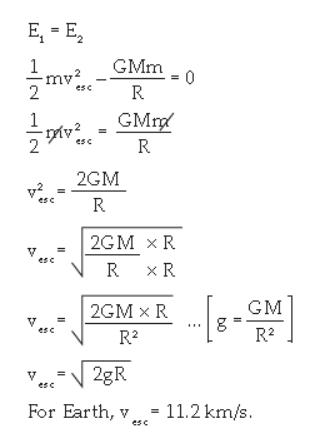
8. Explain the three laws given by Kepler
FIRST LAW: the orbit of a planet is an ellipse with the sun at one of the foci.
SECOND LAW: The line joining the planet and the sun covers areas in equal intervals of time.
Area ASB = Area CSD
THIRD LAW: The square of the period of revolution of a planet around the sun is directly proportional to the cube of the mean distance of a planet from the sun.
When r = average distance of the planet from the sun and
T = period of revolution.
Then, T2α r3 or T2/r3 = K or r3/T2 = 1/K
4 Answer the following (Any one) (5 Marks)
-
Define acceleration due to gravity (g) and derive an expression for it. State and explain any two factors which affect the acceleration due to gravity.
Acceleration due to gravity:
The acceleration produced in a body under the influence of the force of gravity alone is called acceleration due to gravity. It is denoted by ‘g’.
Expression for acceleration due to gravity:
Suppose an object of mass ‘m’ is situated at a distance ‘R’ from the centre of the earth.
Let ‘M’ be the mass of the earth, then the gravitational force of attraction F between the object and the earth is given by,
F = G Mm/R2
Where, G = constant of gravitation
F/m = G M/R2 ….(1)
But acceleration is given by acceleration due to gravity.
g = force/mass = F/m ….(2)
From equations (1) and (2), we have, acceleration due to gravity on the earth’s surface,
g = GM /R2
From the above relation, acceleration due to gravity on earth’s surface depends upon the mass of the earth (M) and distance (R) of the object from the centre of the earth i.e., the radius of the earth.
The following factors affect the value of gravitational acceleration of the earth ‘g’: Gravitation Test Answers
- Shape of the earth:
- The shape of the earth is not perfectly spherical. It is slightly flattened at the poles and bulged at the equator.
- As a result, the radius of the earth at the poles is less than that at the equator.
- Hence, the value of ‘g’ is highest at the poles (9.832 m/s2) and decreases slowly with decreasing latitude. It is the lowest at the equator (9.78 m/s2).
- Height:
- As the height of an object from the surface of the earth increases, the distance between the object and the centre of the earth (r) increases.
- As a result, the value of ‘g’ decreases with increase in height.
- Depth:
- The value of g is maximum on the surface of the earth.
- As depth of an object increases, the distance between the object and the centre of the earth (r) decreases.
- Along with the distance, the part of the earth which contributes towards the gravitational force felt by the object (M) also decreases.
- Thus, due to the combined effect of changing value of r and M, the value of ‘g’ decreases.
- At the centre of the earth, the value of ‘g’ becomes zero.
-
Define/write the laws
1. Force
The force is that physical quantity which changes or tends to change the state of rest or of uniform motion in a straight line.
2. Universal constant of gravitation
Universal constant of gravitation is the force of attraction between two unit masses placed at unit distance apart from each other
3. free fall
When a body falls towards the Earth under the influence of the Earth’s gravity alone, its motion is called a ‘free fall’.
4. Uniform circular motion
When an object moves in a circular path with uniform speed, its motion is uniform circular motion.
5. Mass
The mass of an object is the quantity of matter contained in it. Mass is the measure of the inertia of a body.
Gravitation Test Answers
